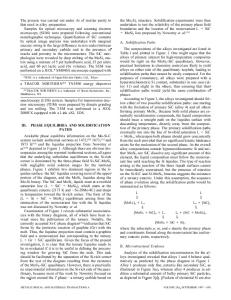Tailored MoSi 2 /SiC composites by mechanical alloying
- PDF / 2,298,976 Bytes
- 14 Pages / 576 x 790 pts Page_size
- 10 Downloads / 351 Views
MoSi2-based composites have been synthesized through the mechanical alloying (MA) of elemental molybdenum and silicon powders with and without carbon additions. The interplay between the phase formation sequence in the powders and the microstructural evolution in the consolidated samples is described. It is shown that the glassy SiC>2 phase characteristic of conventional powder processed MoSi2 can be effectively eliminated by combining mechanical alloying, carbon additions, and an in situ carbothermal reduction reaction. Using this approach, composites consisting of uniformly distributed micron-size SiC in an M0S12 matrix can be formed. The effect of important processing variables such as the extent of carbon additions, extraneous iron pickup during MA, partial pressures of oxygen, consolidation temperatures, and consolidation atmospheres is discussed based on the evidence obtained from DTA, TGA, TEM, and XRD.
I. INTRODUCTION The intermetallic MoSi2 has long been considered a potential material for high-temperature structural applications due to its high melting point, excellent oxidation and corrosion resistance, low density, and good electrical and thermal conductivity. Similar to many other hightemperature intermetallics, the use of MoSi2 is limited as a structural material due to its low ambient temperature fracture toughness and poor elevated temperature strength. A number of approaches for the processing of this intermetallic are unsuitable due to its high melting point and owing to the fact that it exists as a line compound. Furthermore, the relatively high dissociation pressures of MoSi2 at elevated temperatures result in uncontrolled second phase formation due to silicon volatilization.1'2 In view of these characteristics, powder processing appears to be the preferred fabrication route due to the lower processing temperatures that it affords; unfortunately, it also results in the incorporation of silica (originally formed as a surface layer on the powder particles3) into the consolidated samples. The presence of grain boundary silica either as a continuous film or as discrete particles is expected to be detrimental, since the particles may serve as crack nucleation sites at lower temperatures, while enhancing deformation via grain boundary sliding at temperatures above 1200 °C where the silica softens appreciably. In fact, recent studies have shown that low silica polycrystalline MoSi2 demonstrates negligible "plasticity" below 1400 °C.4 Silica formation also alters the matrix stoichiometry and results in the formation of Mo 5 Si 3 . Such stoichiometric deviations degrade the intermediate temperature oxidation resistance5 of the 1428 http://journals.cambridge.org
J. Mater. Res., Vol. 8, No. 6, Jun 1993
Downloaded: 07 Apr 2015
silicide. Finally, silica has also been reported to cause the degradation of the diffusion barrier coatings at the fiber-matrix interface in ductile fiber-reinforced MoSi2.6 In attempting to control the oxygen content of MoSi2 by varying the starting powder size and by intentional
Data Loading...











